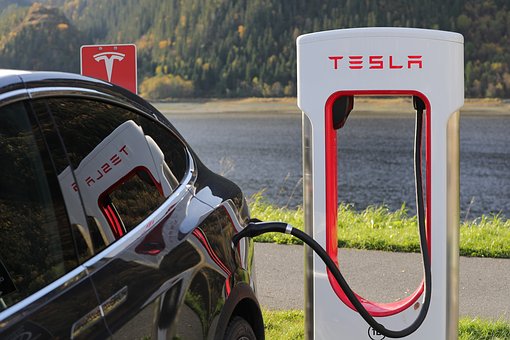Electric vehicles

|
| Tesla's Model X electric car has a 100kWh battery that provides a range of 351 miles. |
Contents |
[edit] Introduction
Electric vehicles (EVs) are typically cars, although they can be motorcycles, trains, buses, trams, trucks, aircraft, ships, submarines and other vehicle types. They may have one or more motors powered by electric batteries, as opposed to an internal combustion engine.
[edit] Benefits and drawbacks
Compared to petrol-driven varieties, electric vehicles tend to be quieter, cheaper to run and have no exhaust emissions, however the carbon footprint will depend on how the electricity driving the vehicle has been generated. Electricity derived from wind, tidal and solar has a better carbon footprint than that generated from fossil fuels.
Potential drawbacks of EVs include relatively high purchase costs, limited choice of models, battery life and replacement costs, and lower range compared to petrol-driven vehicles.
[edit] Charging methods
Batteries can be recharged either by off-vehicle electricity sources or integrated sources such as solar panels and fuel cells. Lithium-ion (Li-Ion) batteries are generally the predominant type used for EVs as they are longer lasting and have a higher energy- and power-density than most other battery types. Li-Ions have superceded the earlier and pricier nickel metal hydride batteries due to the latter’s tendency to lose charge in heat.
Cars recharged from external electricity sources are known as plug-in electric vehicles (PEVs), with the Nissan Leaf being the world’s top-selling model (2018). Cars that combine conventional fuel-powered engines with electric propulsion are known as hybrid electric vehicles (HEVs), a market dominated by Japan followed by the US and Europe.
In the UK, the 12 months to December 2018 saw a dramatic slowdown in sales of electric cars which is undermining government plans to cut roadside emissions. This is attributed to factors, including public scepticism over safety issues, a lack of charging points, few affordable models, cuts in green car incentives by the UK government and sluggish progress in EV roll-out.
[edit] Automated vehicles
EV technology lends itself more readily to automation than conventional technology and this has generated much interest in autonomous vehicles (AVs). There are varying levels of automation for road vehicles: fully autonomous, where the AV can complete journeys safely without a driver in normally-encountered traffic conditions, and highly automated, where the vehicle can operate in driverless mode but must have a driver on-board to take control if necessary.
AVs will potentially transform cities due to zero exhaust emissions, safer roads, fewer accidents, less congestion and smoother traffic flow, with extensive freeing-up of conventional parking space. It could also bring about changes in car ownership patterns and raise questions in terms of insurance. If an accident occurs with a fully autonomous vehicle, who is responsible? The vehicle provider, the manufacturer or the software developer?
[edit] Progress
In July 2019, the government launched a consultation on proposals to alter existing residential and non-residential buildings regulations to include electric vehicle infrastructure requirements. Ref https://www.gov.uk/government/consultations/electric-vehicle-chargepoints-in-residential-and-non-residential-buildings
NB Making Mission Possible - Delivering A Net-Zero Economy, published by the Energy Transitions Commission (ETC) in September 2020, suggests a fuel cell electric vehicle (FCEV) is an: ‘Electric vehicle using a fuel cell generating electricity to power the motor, generally using oxygen from the air and compressed hydrogen.’
[edit] Related articles on Designing Buildings
- Autonomous vehicles.
- Battery electric vehicle.
- Boosting electric vehicle use.
- Drivers uncertain over electric vehicles.
- ECA and UKPN launch EV guide.
- ECA backs joint rail electrification statement.
- ECA calls for urgent energy price reform.
- ECA warns lack of EV strategy could leave UK divided.
- Electric car charging stations - what you need to know.
- Electric vehicles in 2021.
- Electricity.
- Fuel.
- Fuel cells.
- Hybrid electric vehicle.
- Hydrogen fuel cell electric vehicle.
- Key notes on electric car charging points.
- London car charging infrastructure.
- New style EV charging stations.
- Opportunities for EV charging.
- Pop-up electric vehicle charge points.
- Transport Decarbonisation Plan.
- Two thirds of local authorities have no plans to install EV chargers.
- Vehicle to grid.
- Zero-emissions vehicles.
Featured articles and news
Homes England supports Greencore Homes
42 new build affordable sustainable homes in Oxfordshire.
Zero carbon social housing: unlocking brownfield potential
Seven ZEDpod strategies for brownfield housing success.
CIOB report; a blueprint for SDGs and the built environment
Pairing the Sustainable Development Goals with projects.
Types, tests, standards and fires relating to external cladding
Brief descriptions with an extensive list of fires for review.
Latest Build UK Building Safety Regime explainer published
Key elements in one short, now updated document.
UKGBC launch the UK Climate Resilience Roadmap
First guidance of its kind on direct climate impacts for the built environment and how it can adapt.
CLC Health, Safety and Wellbeing Strategy 2025
Launched by the Minister for Industry to look at fatalities on site, improving mental health and other issues.
One of the most impressive Victorian architects. Book review.
Common Assessment Standard now with building safety
New CAS update now includes mandatory building safety questions.
RTPI leader to become new CIOB Chief Executive Officer
Dr Victoria Hills MRTPI, FICE to take over after Caroline Gumble’s departure.
Social and affordable housing, a long term plan for delivery
The “Delivering a Decade of Renewal for Social and Affordable Housing” strategy sets out future path.
A change to adoptive architecture
Effects of global weather warming on architectural detailing, material choice and human interaction.
The proposed publicly owned and backed subsidiary of Homes England, to facilitate new homes.
How big is the problem and what can we do to mitigate the effects?
Overheating guidance and tools for building designers
A number of cool guides to help with the heat.
The UK's Modern Industrial Strategy: A 10 year plan
Previous consultation criticism, current key elements and general support with some persisting reservations.
Building Safety Regulator reforms
New roles, new staff and a new fast track service pave the way for a single construction regulator.























Comments